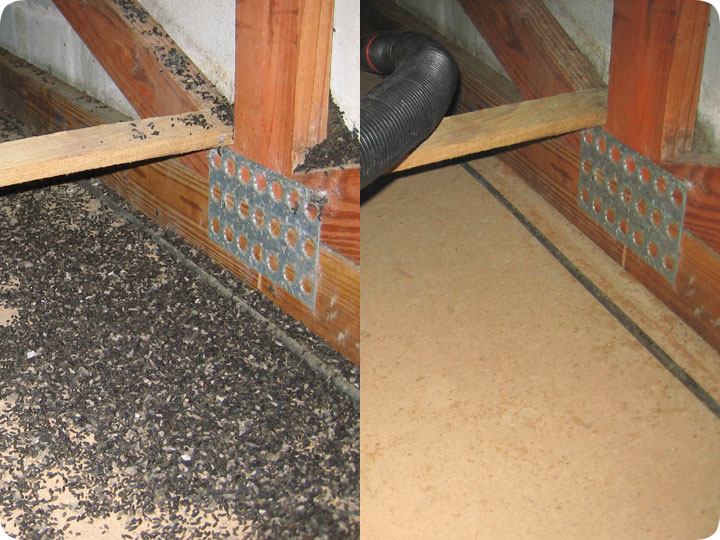-
info@aaanimalcontrol.com
Call us for help in your town
Humane Wildlife Education
Bat Droppings and Histoplasmosis

What is histoplasmosis? It is a respiratory disease, or infection of the lungs, whose symptoms vary from the usual flu-like symptoms to more serious effects if the disease becomes systemic. This latter form of the disease, acute or disseminated histoplasmosis, can spread from the lungs to other organs. This is a life-threatening conditon, but it is rare, and only persons with weakened immune systems are susceptible as far as I know. Histo is caused by Histoplasma capsulatum, a fungus. The fungus produces spores that, when airborne, a person can inhale. Spores are hardy forms of the fungus that can live in the attic for a long time. The fungus grows well in nitrogen-rich environments such as accumulations of bat guano and bird droppings. This is one of the reasons it's usually a good idea to remove bat droppings from an attic and decontaminate the area. Here is my list of good reasons to remove bat droppings:
- The droppings carry an offensive odor - as expected, the more the droppings, the worse the odor.
- The droppings can seep through ceiling/walls and cause stains.
- The droppings, if in large enough accumulation, can become heavy enough to collapse a ceiling (I've seen this twice).
- The droppings tend to attract the vermin that tend to like poop - I've seen hundreds of cockroaches crawling on guano.
- The droppings may attract other bats to the area - this theory seems to hold true for many animals.
- The droppings may grow the Histoplasma capsulatum fungus, which can cause respiratory infections.
- Vampire bats will, on occasion, rise from deep within a pile of guano to break free and feast on the blood of the innocent.
- Exposure to too many attics with bat droppings can cause a wildlife trapper to become delusional.
Do it yourself: Visit my How To Get Rid of Bats page for tips and advice.
Get professional help: Visit my Nationwide Pro Directory of wildlife removal experts.
For more wildlife stories, click my Wildlife Blog or click my below banner to hire a local trapper.

Bat droppings are not very pleasant when you run across them in your attic or building. It wasn’t always unpleasant. Long ago, many different cultures would think highly of the feces because it contained nitrogen, potassium, as well as phosphates as it was great for gardening. Over time, and after carefully analyzing the feces more, it was discovered to have several very dangerous diseases that can be transmitted from bat to human or bat to another animal when in direct contact with it.
Identifying
Because bat feces are normally dropped from the location where the bats roost, the feces tend to accumulate on a pile below. The feces are normally black and can be discovered in long pellets that are thin. Bats feed mainly on insects which can leave shiny pieces or speckled pieces within their feces, such as an insect wing that just didn’t break down completely in the digestive tract.
How to Handle Bat Droppings
Once you discover bat droppings, you will want to take special care when removing them. Because the spores within the bat poop can be inhaled, you will want to wear a mask. You will need a bag to dispose of the feces once you do pick it up so make sure you also have gloves as well. Once you have picked up all the feces, you will want to double bag it before disposing of it.
After removing the feces, you will want to clean and disinfect the area. You again will need to wear a mask and gloves when cleaning the area. If the bat feces went into the insulation, you may need to remove it in order to completely clean the area.
Histoplasmosis
When dealing with bat droppings, it's extremely important to always wear a mask in order to avoid breathing in the spores of the fungus that exist within the feces itself. One such disease that can be transmitted from bat to human through the feces is Histoplasmosis. As you clean up the feces, the spores are released into the air making it dangerous for anyone nearby not wearing a mask.
Histoplasmosis can be dangerous for anyone who has a compromised immune system and for infants who don’t have a strong immune system yet.
Symptoms of Histoplasmosis
The symptoms are sometimes never experienced. For others, they may be mild and in some cases, they can be life-threatening. Symptoms can start to show in as little as three days or up to seventeen days after exposure. These symptoms can include:
- Chills
- Fever
- Muscles aches
- Chest discomfort
- Dry cough that doesn’t go away
- Headache
- Fatigue




















